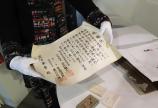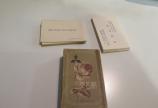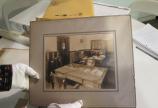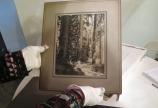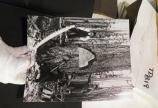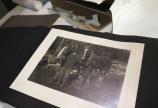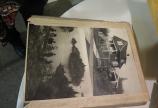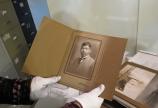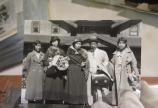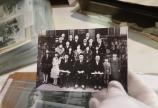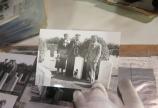Acquisition of Japanese-Canadian heirlooms now part of $5.5M Landscapes of Injustice project
- Tara Sharpe

It’s not every day museum staff from Vancouver travel thousands of kilometres to a southeastern state in the US known for its Appalachian mountains and humid swamp forests to bring home priceless family heirlooms related to Japanese-Canadian history in BC. Sherri Kajiwara and Linda Kawamoto Reid of the Nikkei National Museum & Cultural Centre (NNMCC) in Burnaby did exactly that last fall.
An invaluable donation for national museum in Burnaby
Kajiwara and Kawamoto Reid travelled to North Carolina to acquire historical material of Eikichi Kagetsu, a lumber baron who first came to Canada in 1906 and whose property held an approximate value of $8 million in today’s dollars when it was forcibly dispossessed in 1943. His story serves as a stark reminder of a national historical injustice and will feature prominently in an ambitious humanities project led by UVic and culminating in a nation-wide museum exhibition, as well as teaching tools for all Canadians.
The collection of six banker boxes weighing more than 200 lbs. had been painstakingly compiled by Kagetsu’s son Jack. The acquisition by the NNMCC,officially announced June 29, fulfilled a promise made to Jack—who spent 10 years travelling around BC, as well as to the national archives in Ottawa, the Japanese consulate in NYC and various archives in Japan, to reconstruct the story of what had happened—before his death in 2006.
Media in Canada picked up the news, with interviews in the Globe and Mail,Metro Vancouver, Times Colonist, CFAX Radio and CBC Radio's On the Coastand All Points West.
The donation includes diaries, photos, charcoal drawings, business cards, brocade books and precious textile items. Importantly, there are also notes and records, as well as the manuscript by Jack about his father’s life.
The Kagetsu home in North Carolina had flooded during a storm; there was also the possibility of mold or insects. So, upon its arrival at the Burnaby museum, the material from the boxes was immediately wrapped in plastic bags and temporarily transferred to a freezer off-site to halt the growth of mold and eliminate any insects.
A dynamic multimillion-dollar project to restore history
This carefully preserved history of one man’s legacy serves as one of many to be revealed, rediscovered and restored by the team and partners ofLandscapes of Injustice, the seven-year, multimillion-dollar research project on the history of the dispossession of property of Japanese Canadians during the 1940s.
“This project is enriched by this acquisition,” says UVic historian and project director Jordan Stanger-Ross. “The story of the Kagetsu family is one of many that need to be told.”
- Read the capsule story on Jack Kagetsu’s 10-year search
- Read the capsule story on the journey from N. Carolina to the deep freeze
- Read the UVic feature story on the launch of Landscapes of Injustice
In February 1942, the federal government made the decision to uproot and intern all 22,000 Canadians of Japanese ancestry living in coastal BC. Then on March 27, a federal Order-in-Council was passed, promising to protect Japanese-Canadian-owned property and return it to its rightful owners after the war. Japanese Canadians relinquished their life belongings in trust, although some secreted their smaller possessions away behind the walls of their homes, deeply suspicious of their own government’s motives. Less than one year later, the government passed a new Order-in-Council, reneging on that promise: everything would be sold.
Kagetsu’s grandson Nolan, who was born in Ontario and now makes his home in New York, recently recalled through his sister that their grandfather and his family was interned in Minto, BC. (The family moved to Toronto immediately after the war and eventually to the US.) Kajiwara, a member of the Landscapes of Injustice executive committee and director-curator of the NNMCC, explains that the Minto internment camp was self-supporting, which meant the Kagetsu family would have directly funded their move and expenses at the camp and it might also explain how cherished items stayed in the family’s possession.
She adds, “As far as I’m concerned, all Japanese Canadians in BC were ‘incarcerated’ and all the internment camps were ‘self-supporting,’” as money from the sale of dispossessed property would have been used to pay for the operation of camps in BC.
Stanger-Ross has reflected before that the story of dispossession is not well known, and that all Canadians “risk overlooking the most important lessons of our past if we do not hold deep conversations about the legacies of twentieth-century racism. The willingness to confront a difficult past is a measure of democracy.”
An esteemed man, known to the Emperor
Eikichi Kagetsu was president of the Canadian Japanese Association for 10 years and received commemorative gifts from members of the royal family of Japan, one item being a beautiful scroll that later hung in the family home. “It was his favourite scroll,” Kajiwara explains.
Before the war, Kagetsu had owned his own railroad track, a small town for company workers, an oyster business and prime real estate including a family home in Kerrisdale, an office in downtown Vancouver, a summer house in West Vancouver and a Deep Bay logging operation in Fanny Bay on Vancouver Island.
“His archives contain artifacts that were probably gifts that have been passed down through three generations and eventually saved in North Carolina,” explains Kawamoto Reid, research archivist for the NNMCC. For Kawamoto Reid, working through the artifacts “show just how venerated and esteemed he was.”
“It was a sense of betrayal, a complete reversal,” says UVic master’s candidate Kaitlin Findlay (history) of the war-time laws. Findlay, who has seen what’s in the banker boxes, is one of many student researchers engaged in the Landscapes of Injustice project. She adds, “Looking through the photographs, I was struck by how close this past is. Eikichi’s children could be my classmates. What would I have done in their place? I can only admire the family’s resiliency in face of such calamity.”
The NNMCC, which houses archival materials, art and artifacts relating to Japanese-Canadian heritage, will co-curate the museum exhibit to tour Canada in 2021. The NNMCC is a major partner of Landscapes of Injustice.
Project phases: now in year three
The first four years of the project comprise the research phase, which includes traditional archival historical research combined with extensive real-estate title searches, oral history interviews and geo-visual mapping, approaches that are brought together at the research collective’s annual Spring Institutes. This first phase focuses on four locations—Steveston; Maple Ridge; Salt Spring Island; Powell Street in downtown Vancouver.
Phase two (2018 to 2021) will involve the creation of the museum exhibition; an educational website; a digital archive of research materials; teaching resources for elementary and secondary school instructors; and additional community outreach activities.
Institutional partners and funding
The UVic-led project includes 15 other institutions—with Library and Archives Canada and the National Association of Japanese Canadians the newest partners, in addition to the original 13 (see 2014 backgrounder).
This dynamic public history project, funded by $2.5 million from the Social Sciences and Humanities Research Council and $3 million in matching contributions from the institutional partners, is currently one of the biggest research projects in the field of humanities in Canada.
The project also brings together researchers in three faculties at UVic—humanities, social sciences and law.
See Dropbox for more photos from the collection (http://bit.ly/28SYU50).
See UVic.ca/news archive for the original announcement.

